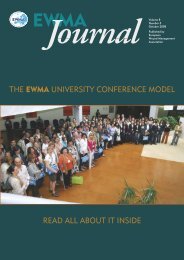Create successful ePaper yourself
Turn your PDF publications into a flip-book with our unique Google optimized e-Paper software.
The use of telemedicine<br />
in wound care<br />
Most patients suffering from chronic<br />
wounds are attended to by local district<br />
nurses and may geographically be<br />
far away from specialist centres. A need for specialist<br />
advice may, however, turn up often resulting<br />
in a tedious process for the patient. A remission<br />
note is forwarded to the hospital and the patient is<br />
allocated an appointment, perhaps days or weeks<br />
later in the outpatient clinic. During the waiting<br />
time the wound may have worsened and become<br />
more resistant to treatment.<br />
To deal with this, we have introduced telemedicine<br />
in Soenderjylland, Denmark, as a tool to<br />
communicate, in a fast way, between the wound<br />
care nurses in the local communities and the hospitals.<br />
This concept we have named “Saar-I-Syd”<br />
(“Wounds-in-the South”).<br />
We applied the experiences, from two PhD<br />
projects based in the Department of Endocrinology<br />
M, Aarhus Universityhospital and Centre<br />
for Pervasive Health Care, Alexandra Instituttet,<br />
ISIS Katrinebjerg, Aarhus. In these studies the<br />
technology was developed and tested 1 . In the sec-<br />
Fig 1.<br />
The set-up, diagram<br />
ond study 2 local district nurses in Aarhus participated<br />
in the development of a real-time on-line<br />
teleconsultation, which was proven to be fully<br />
exchangeable to a standard in-hospital consultation.<br />
In “Saar-I-Syd” the web-based database was<br />
adapted to our needs through collaboration with<br />
the software company Dansk Telemedicin A/S.<br />
Telemedical consulations are now used in Soenderjylland<br />
(220.000 inhab.) as an interdisciplinary<br />
tool to remit patients with venous leg ulcers, arterial<br />
ulcers, diabetic foot ulcers, pressure sores<br />
and inflammatory ulcers to the specialists in the<br />
hospitals, to communicate between the different<br />
sectors, thus avoiding visits to the outpatient<br />
clinic, to control quality of the treatment given<br />
and to support the district nurses in their handling<br />
of the patients with chronic wounds.<br />
HOW IS THIS DONE?<br />
When the district nurse sees a patient with a<br />
chronic wound, the patient is registered in our<br />
web-based electronic database. Only healthcare<br />
�<br />
Background Article<br />
Rolf Jelnes, MD1<br />
Niels Ejskjaer, MD 2<br />
1 Saar-I-Syd,<br />
Department of<br />
Vascular Surgery,<br />
Sygehus Soenderjylland,<br />
Aabenraa,<br />
Denmark<br />
2 Diabetic Foot Centre,<br />
Department of Medicine M,<br />
Aarhus University Hospital,<br />
Denmark<br />
rolf.jelnes@get2net.dk<br />
<strong>EWMA</strong> Journal 2007 vol 7 no 2 5

















